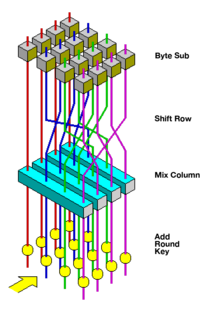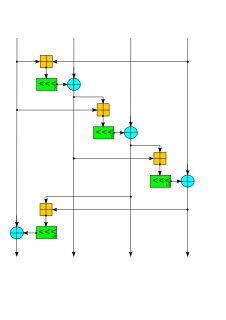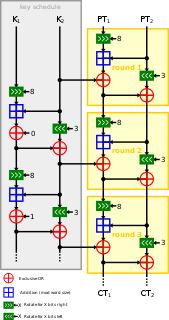
The Advanced Encryption Standard (AES), also known by its original name Rijndael, is a specification for the encryption of electronic data established by the U.S. National Institute of Standards and Technology (NIST) in 2001.
Blowfish is a symmetric-key block cipher, designed in 1993 by Bruce Schneier and included in many cipher suites and encryption products. Blowfish provides a good encryption rate in software, and no effective cryptanalysis of it has been found to date. However, the Advanced Encryption Standard (AES) now receives more attention, and Schneier recommends Twofish for modern applications.
In cryptography, a block cipher is a deterministic algorithm operating on fixed-length groups of bits, called blocks. They are specified elementary components in the design of many cryptographic protocols and are widely used to the encryption of large amounts of data, including data exchange protocols. It uses blocks as an unvarying transformation.

In cryptography, the International Data Encryption Algorithm (IDEA), originally called Improved Proposed Encryption Standard (IPES), is a symmetric-key block cipher designed by James Massey of ETH Zurich and Xuejia Lai and was first described in 1991. The algorithm was intended as a replacement for the Data Encryption Standard (DES). IDEA is a minor revision of an earlier cipher Proposed Encryption Standard (PES).
In cryptography, Lucifer was the name given to several of the earliest civilian block ciphers, developed by Horst Feistel and his colleagues at IBM. Lucifer was a direct precursor to the Data Encryption Standard. One version, alternatively named DTD-1, saw commercial use in the 1970s for electronic banking.

Serpent is a symmetric key block cipher that was a finalist in the Advanced Encryption Standard (AES) contest, where it was ranked second to Rijndael. Serpent was designed by Ross Anderson, Eli Biham, and Lars Knudsen.

In cryptography, the Tiny Encryption Algorithm (TEA) is a block cipher notable for its simplicity of description and implementation, typically a few lines of code. It was designed by David Wheeler and Roger Needham of the Cambridge Computer Laboratory; it was first presented at the Fast Software Encryption workshop in Leuven in 1994, and first published in the proceedings of that workshop.
In cryptography, Camellia is a symmetric key block cipher with a block size of 128 bits and key sizes of 128, 192 and 256 bits. It was jointly developed by Mitsubishi Electric and NTT of Japan. The cipher has been approved for use by the ISO/IEC, the European Union's NESSIE project and the Japanese CRYPTREC project. The cipher has security levels and processing abilities comparable to the Advanced Encryption Standard.
In computer science and cryptography, Whirlpool is a cryptographic hash function. It was designed by Vincent Rijmen and Paulo S. L. M. Barreto, who first described it in 2000.
In cryptography, SAFER is the name of a family of block ciphers designed primarily by James Massey on behalf of Cylink Corporation. The early SAFER K and SAFER SK designs share the same encryption function, but differ in the number of rounds and the key schedule. More recent versions — SAFER+ and SAFER++ — were submitted as candidates to the AES process and the NESSIE project respectively. All of the algorithms in the SAFER family are unpatented and available for unrestricted use.
In cryptography, Khufu and Khafre are two block ciphers designed by Ralph Merkle in 1989 while working at Xerox's Palo Alto Research Center. Along with Snefru, a cryptographic hash function, the ciphers were named after the Egyptian Pharaohs Khufu, Khafre and Sneferu.

Salsa20 and the closely related ChaCha are stream ciphers developed by Daniel J. Bernstein. Salsa20, the original cipher, was designed in 2005, then later submitted to the eSTREAM European Union cryptographic validation process by Bernstein. ChaCha is a modification of Salsa20 published in 2008. It uses a new round function that increases diffusion and increases performance on some architectures.
In cryptography, SC2000 is a block cipher invented by a research group at Fujitsu Labs. It was submitted to the NESSIE project, but was not selected. It was among the cryptographic techniques recommended for Japanese government use by CRYPTREC in 2003, however, has been dropped to "candidate" by CRYPTREC revision in 2013.
In cryptography, MESH is a block cipher designed in 2002 by Jorge Nakahara, Jr., Vincent Rijmen, Bart Preneel, and Joos Vandewalle. MESH is based directly on IDEA and uses the same basic operations.
In cryptography, ARIA is a block cipher designed in 2003 by a large group of South Korean researchers. In 2004, the Korean Agency for Technology and Standards selected it as a standard cryptographic technique.
In cryptography, Treyfer is a block cipher/MAC designed in 1997 by Gideon Yuval. Aimed at smart card applications, the algorithm is extremely simple and compact; it can be implemented in just 29 bytes of 8051 machine code.
The following outline is provided as an overview of and topical guide to cryptography:

In cryptography, Twofish is a symmetric key block cipher with a block size of 128 bits and key sizes up to 256 bits. It was one of the five finalists of the Advanced Encryption Standard contest, but it was not selected for standardization. Twofish is related to the earlier block cipher Blowfish.

Speck is a family of lightweight block ciphers publicly released by the National Security Agency (NSA) in June 2013. Speck has been optimized for performance in software implementations, while its sister algorithm, Simon, has been optimized for hardware implementations. Speck is an add–rotate–xor (ARX) cipher.

Simon is a family of lightweight block ciphers publicly released by the National Security Agency (NSA) in June 2013. Simon has been optimized for performance in hardware implementations, while its sister algorithm, Speck, has been optimized for software implementations.








